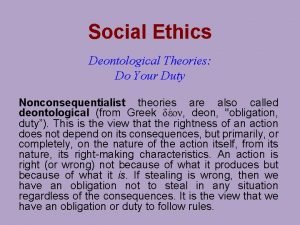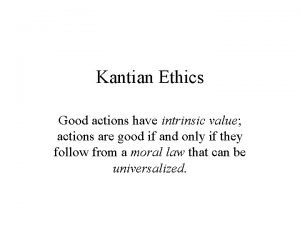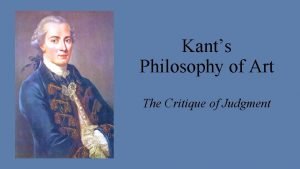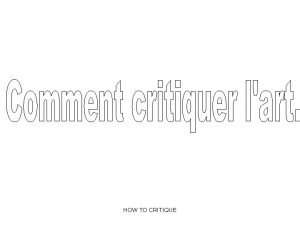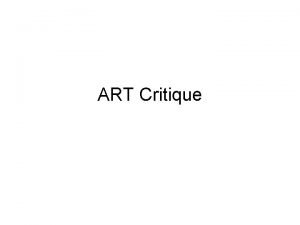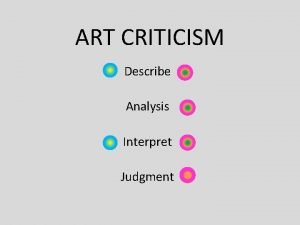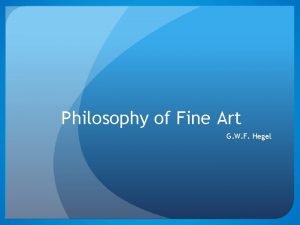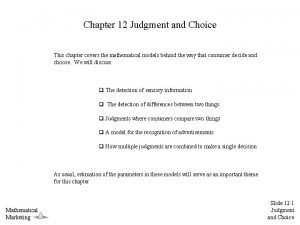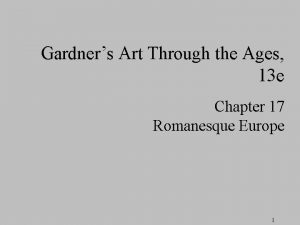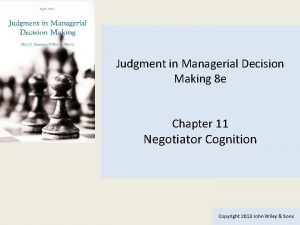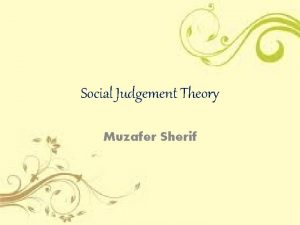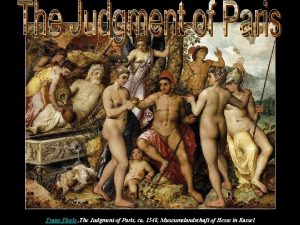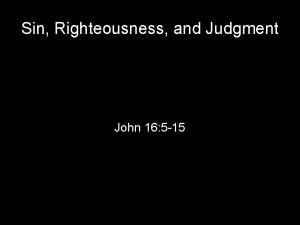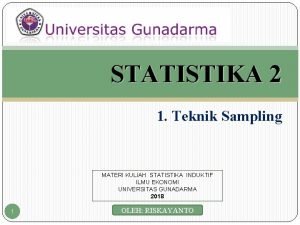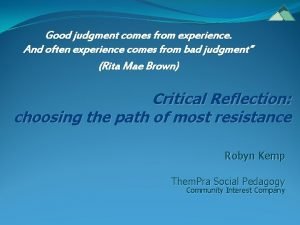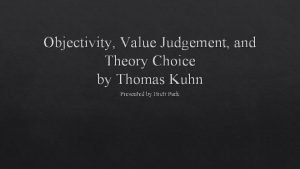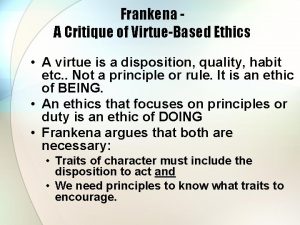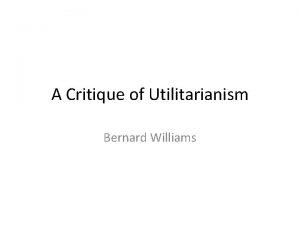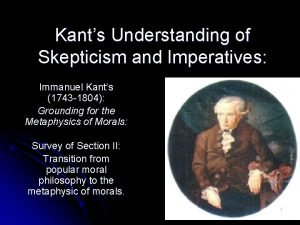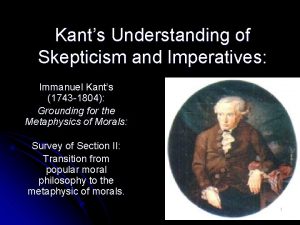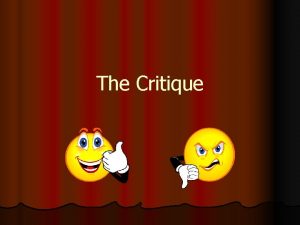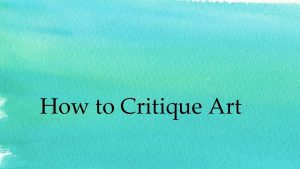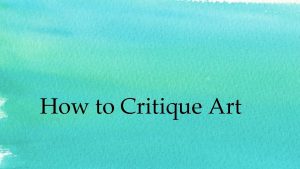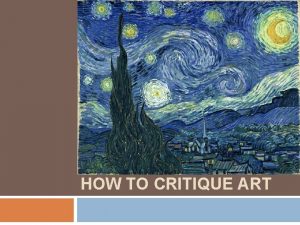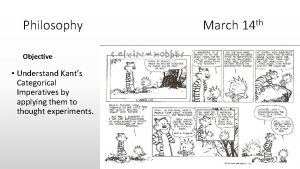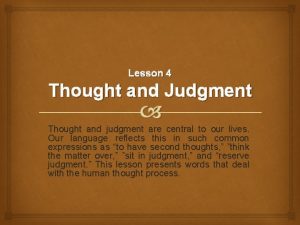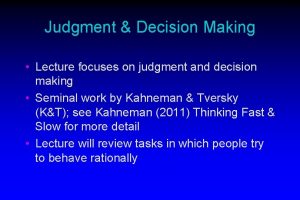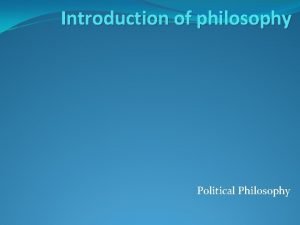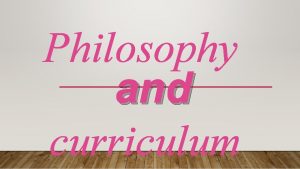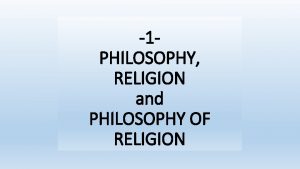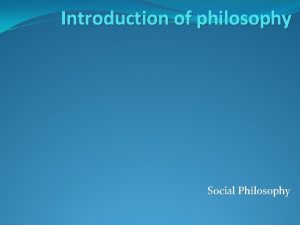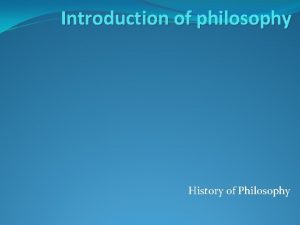Kants Philosophy of Art The Critique of Judgment







































- Slides: 39

Kant’s Philosophy of Art The Critique of Judgment

Modern Philosophy Rationalism Empiricism Knowledge comes from Pure Reason Knowledge comes from the Senses Baruch René Spinoza Descartes (1596 (1632– 1677) – 1650) The Netherlands France Gottfried Leibniz (1646 – 1716) Germany John Locke (1632 -1704) England George Berkeley (1685 -1753) Ireland David Hume (1711 -1776) Scotland

Modern Philosophy Empiricism Rationalism Knowledge comes from Pure Reason Knowledge comes from the Senses The Rationalists were wrong about ignoring the senses. The Empiricists were right that the senses are important for knowledge The Rationalists were right that the mind does contribute something important to knowledge. The input from the senses still has to be organized and made intelligible by the operation of the mind. The Empiricists were wrong about ignoring the contributions the mind makes to knowledge. The input from the senses still has to be organized and made intelligible by the operation of the mind. Immanuel Kant (1724 -1804) Germany .

Hume’s Fork All knowledge is either: Relations of Ideas Matters of Fact A Priori Knowledge Prior to the Senses A Posteriori Knowledge Requires sense evidence Statements that are true by definition Certain Truths Propositions of Mathematics and Geometry Statements that are not true by definition Contingent Truths Statements like: “All bachelors are unmarried men. ” Statements like: “All swans are white. ” Any statement that is a matter of fact statement about the world requires sense evidence.

Kant’s Reply to Hume Relations of Ideas Analytic Truths Matters of Fact Synthetic Truths A Priori Knowledge Prior to the Senses A Posteriori Knowledge Requires sense evidence Synthetic a priori judgements are necessary to all experience. Knowledge about the world does involve an a priori component. Although we rely on experience, on ‘receptivity’ or what Kant calls ‘intuition’ for the particular contents of our knowledge, the structure or form of that experience is provided by the human mind, or what Kant calls the ‘understanding’ (Verstand). Without the mind to provide the structure or form to what is given through the senses we would have no experience of the external world at all. This is what Kant described as the “Copernican Revolution” in philosophy.

Mind is not a simple mirror The Phenomenal World The Noumenal World Reality that appears to human consciousness Reality as it is in-itself The mind is more complex than a simple mirror of nature. What if it is an instrument more like a camera? If one has a black and white camera, one will never get color pictures even though reality in-itself is colored. Thus we have to better understand the instrument of the human mind. The world that shows up for us is going to be determined by the instrument of the human mind. This is what Kant meant by synthetic a priori knowledge.

Kant’s Three Great Critiques The Critique of Pure Reason The Critique of Practical Reason The Critique of Judgment Knowledge Desire Feeling Seeks to establish the foundation for making objective, universally valid empirical judgments about the world—both ordinary and scientific. Focuses on knowledge of Nature which is a realm of necessary laws. Seeks to establish the conditions for making objective, universally valid moral judgments. As morality depends upon freedom, this critique focuses on the realm of freedom. Aims to reunite the worlds of Nature and Freedom. It seeks to establish the a priori conditions for making universally valid aesthetic judgments. The first attempt to integrate aesthetic theory into a complete philosophical system. Nature Freedom Aesthetic

The Critique of Judgment Kant hoped to provide a theory of the aesthetic judgment that would justify its apparent claim to intersubjective validity, and, responding to Hume, escape the temptations of skepticism and relativism. He believed this could be accomplished only by giving a deeper interpretation of art and its values, and by establishing for it a more intimate connection with the basic cognitive faculties of the mind. Whereas the Critique of Practical Reason aims to discover the a priori conditions of making objective, universally valid moral judgments, the Critique of Judgment aims to discover the a priori conditions for making judgments based on feeling.

The Critique of Judgment Seeks to reunite the worlds of Nature and Freedom. It is Aesthetic experience which mitigates the stark opposition between two seemingly incommensurable dimensions of human life: our bodily existence within the deterministic realm of physical nature, and our existence as autonomous rational agents obeying universal dictates of practical reason. Our aesthetic experience delivers an awareness of the meaningfulness or ‘purposiveness’ of nature. Like the natural inevitability of a work of art, such a work seems to be ‘purposive’ but as an “end it itself” has no determinate purpose.

The Critique of Judgment Are there a priori conditions for making judgments based on pleasure? Kant takes as his paradigm the type of judgment everyone believes is based on feeling of pleasure—the judgment that something is beautiful. His epistemology and metaphysics based on division between: Sensibility—the passive ability to be affected by things by receiving sensations; this is not yet at the level of thought, or even experience in any meaningful sense. Understanding—the faculty of producing thoughts; it is non-sensible, discursive, works with general concepts, not individual intuitions. Ordinary experience comes about through the synthesis of these two powers. The Understanding takes the material of sensation and organizes it into a concept resulting in a thought or judgment. By ‘judgment’ Kant simply means experience that results in a claim or assertion about something. The judgment that something is beautiful he calls a ‘judgment of taste. ’

The Critique of Judgment The Analytic of the Beautiful Four Moments 1. Disinterested Pleasure 2. Universal Pleasure 3. The Form of Purposiveness 4. Necessary Pleasure

The Analytic of the Beautiful 1. Disinterested Pleasure Kant concludes that in order to call an object beautiful one must judge it to be the object of an entirely disinterested satisfaction or dissatisfaction: “Taste is the faculty of judging of an object or a method of representing it by an entirely disinterested satisfaction or dissatisfaction. The object of such satisfaction is called beautiful” (103). Thus, aesthetic pleasure comes only to those who attend to the object disinterestedly.

The Analytic of the Beautiful 1. Disinterested Pleasure How does Kant reach this conclusion? He begins with the observation that the judgment of taste is an aesthetic judgment, thus not a cognitive judgment. In a cognitive judgment I use a concept to connect my experience to an object, whereas in an aesthetic judgment, I don’t use a concept, but my own subjective state (sentiment). Thus, when judging something to be beautiful, one is relating the object (one’s awareness of the object) “back to the subject and to its feeling of life, under the name of the feeling of pleasure or displeasure. ” Judgments of taste are thus subjective rather than objective

The Analytic of the Beautiful 1. Disinterested Pleasure Then Kant differentiates pleasure in the beautiful from other pleasures. What is unique about pleasure in the beautiful is that it is “a disinterested and free satisfaction; for no interest, either of sense or of reason, here forces our assent. ” There are two types of interest: 1) by way of sensations in the agreeable the pleasure in the beautiful is not in an object’s gratifying our senses: like sweetness of candy 2) by way of concepts in the good the pleasure in the beautiful is not based on finding some practical use (the mediately good or the useful), nor is it based on fulfilling moral requirements (the morally good). The pleasure in the beautiful is “merely contemplative” a kind of free contemplation and reflection.

The Analytic of the Beautiful 1. Disinterested Pleasure This disinterestedness is what is unique about the judgment of taste. Contemplation and reflection are absent in what pleases through sensation and contemplation and reflection in the practical concerns (the useful or moral) are not free but constrained by definite concepts. The judgment results in pleasure, rather than pleasure resulting in judgment. This leads Kant to claim that aesthetic judgment must concern itself only with forms shape, arrangement, rhythym, etc Kant is thus the founder of all formalism in aesthetics.

The Analytic of the Beautiful 2. Universal Pleasure Kant concludes that “the beautiful is that which pleases universally without [requiring] a concept” (106). This conclusion is badly put since it is plainly false: a beautiful thing does not please everyone. What he means is better put earlier at the beginning of the section: “The beautiful is that which apart from concepts is represented as the object of a universal satisfaction” (103).

The Analytic of the Beautiful 2. Universal Pleasure What Kant means is that aesthetic judgments behave universally. They involve an expectation or claim upon the agreement of others. We make the judgment that something is beautiful ‘as if’ beauty where a real property of the object—in this sense the pleasure in the beautiful is not wholly subjective. We think that others should find the object beautiful as well, while fully recognizing that not everyone will in fact agree. “if he gives out anything as beautiful, he supposes in others the same satisfaction; he judges not merely for himself, but for everyone, and speaks of beauty as if it were a property of things” (104). We tend to see disagreements over judgment of the beautiful as involving error and agreement as more than coincidence.

The Analytic of the Beautiful 2. Universal Pleasure Kant calls this feature of judgments of taste their “subjective universality” (103). He argues for this in two ways: 1) through the concept of disinterestedness if the pleasure in finding something beautiful does not lie in any interest, then one can conclude that it doesn’t depend on private conditions. “Consequently the judgment of taste, accompanied with the consciousness of separation from all interest, must claim validity for every man, without this universality depending upon objects” (103).

The Analytic of the Beautiful 2. Universal Pleasure 2) to say that something is beautiful is (linguistically) to claim universality for one’s judgment. This universality is distinguished first from the mere subjectivity of judgments like “I like honey. ” Such a judgment is not universal, nor do we expect it to be. Secondly, it is distinguished from the strict objectivity of judgments like “honey contains sugar and is sweet. ” Here the judgment is based on a concept— the sweetness of sugar.

The Analytic of the Beautiful 2. Universal Pleasure Judgments of taste are not objective, but only subjectively universal. They cannot be proved like the judgment that “honey contains sugar and is sweet” and thus Kant emphasizes that “there can be no rule according to which anyone is to be forced to recognize anything as beautiful” (106). At this point Kant’s explication of the judgment of taste seems to lead to an insoluble problem: the judgment of taste is based on feeling of pleasure, but it also claims universal validity. Yet judgments of taste cannot be proved since they do not rest on concepts or rules.

The Analytic of the Beautiful 2. Universal Pleasure The crucial question, the key to the critique of taste, is how is it that the feeling of pleasure in the beautiful is universally communicable? The answer is that the pleasure is universally communicable only if it is based not on mere sensation, but on a state of mind that is universally communicable. Since the only universally communicable states of mind are cognitive states, somehow the pleasure in the beautiful must be based on cognition. But he has already determined that a judgment of taste is not cognitive, in that there is no referring to a concept, but rather to a feeling. Thus his answer is that the pleasure underlying the judgment of taste is not based on a particular cognitive state of mind, but only on “cognition in general. ”

The Analytic of the Beautiful 2. Universal Pleasure The judgment of taste is thus based on the free play of the cognitive faculties: imagination: that which gathers together the stuff of our experience into definite images or representations understanding: forms definite concepts from these representations In aesthetic experience the same two faculties operate together, however the end result is not a definite concept. Instead the two faculties interact in free play: the imagination forms a representation of the object, but unlike in the case of cognition, the understanding does not form a definite concept, for in aesthetic experience no definite concept could adequately capture what we observe. In aesthetic experience the two faculties do not come to a definite conclusion but they work back and forth in a free play between imagination and understanding.

The Analytic of the Beautiful 2. Universal Pleasure Take the case of the experience of a flower: In the case of cognition, the imagination presents to the understanding a representation of the flower. The understanding then determines the appropriate concept (e. g. , a petunia), completing the process of cognition. But in aesthetic experience, this process does not come to a completion but works back and forth, the understanding still seeks understanding, but the imagination is continually reworking its representations. Thus in aesthetic experience there is more than understanding can grasp. The understanding, however, stimulates the imagination into further reformulations. The aesthetic experience thus enhances our experience of the object’s particularity while cognition seeks generically classifiable features.

The Analytic of the Beautiful 3. The Form of Purposiveness without Purpose Here Kant sets out to explain what is being related to in the judgment that something is beautiful, in other words, he is considering the content of the judgment of taste. Kant concludes it is the form of the purposiveness or finality of an object, insofar as this is perceived without any representation of a purpose. Here he is introducing an interesting notion, “purposiveness without purpose. ” “Beauty in the form of the purposiveness of an object, so far as this is perceived in it without any representation of a purpose” (111).

The Analytic of the Beautiful 3. The Form of Purposiveness without Purpose The straightfoward (easier) part of the third moment is that the pleasure in the beautiful is based on the perceived form of the object. Kant argues that a pure judgment of taste cannot be based on pleasures of charm or emotion, nor simply on empirical sensations such as charming colors, nor on a definite concept, but only on formal properties. These formal properties are essentially spatial and temporal relations manifested in the spatial delineation or design of figures or the temporal composition of tones.

The Analytic of the Beautiful 3. The Form of Purposiveness without Purpose The harder part of the third moment concerns the concept of “purposiveness without purpose. ” An object’s purpose is the concept according to which it was manufactured. The purposiveness is then the property of appearing to have been manufactured according to some purpose. To say that an object (say a knife) has a purpose is to say that the concept of its being the way it is, having the form it has, came first and is the cause of its existence. The knife’s form makes sense because we know its purpose—its purpose is to cut. The judgment as to whether the knife is a good one is based on utility—does it serve its purpose? To see something as beautiful, according to Kant, is to see it as purposive. We see an object to be purposiveness in its form, but there is no concept by which we can identify a definite purpose. Kant identifies two primary examples of such purposeless purpose—one natural, the other cultural: the living organism and the work of art.

The Analytic of the Beautiful 4. Necessary Pleasure Kant is trying to show here that aesthetic judgments must pass the test of being “necessary, ” which means “according to principle. ” “The beautiful is that which without any concept is cognized as the object of a necessary satisfaction” (113) When we find something beautiful, we think that everyone ought to give their approval and also describe it as beautiful; but this necessity is of a peculiar sort—its necessity is not theoretical and objective as we cannot prove that everyone will find the same object beautiful. Nor can it be a practical necessity—there is no moral ground for this necessity.

The Analytic of the Beautiful 4. Necessary Pleasure Kant calls the necessity “exemplary”—this means that the judgment does not follow from or produce a determining concept. He then also describes this subjective necessity as “conditioned”—here Kant reaches the core of the matter. He is asking: what is it that the necessity of the judgment is grounded upon? His answer is that it is based on a “ground that is common to all. ” He describes this as “common sense, ” but this does not mean “common sense” in the familiar sense. Here is where we see the connection to the first critique. It is a sense that is common to all of us. Just as we cannot but see the world as causally conditioned, the causal connection is a synthetic a priori principle—one of the “categories” of Understanding, similarly, Kant assumes all of us have this common sense. This common sense is “a subjective principle which determines what pleases or displeases only by feeling and not by concepts, but yet with universal validity” (112). It is thus is a common sense that is exemplary—an ideal or norm—but is presupposed by all aesthetic judgment.

The Deduction of the Judgments of Taste Strictly speaking the “Analytic of the Beautiful” was only supposed to show what is required to call an object beautiful—to give an explanation of what a judgment of taste means. Kant also begins to discuss the problem of whether one can ‘provide a deduction’ (show the legitimacy) of a class of judgment “which imputes the same satisfaction necessarily to everyone. ” This is what he thinks subsumes the Critique of Judgment under transcendental philosophy. He thus raises the key question of philosophical aesthetics: Is it legitimate to make a judgment based merely on the pleasure experienced in perceptually apprehending something, while implying that everyone ought to agree? Kant believes he has established a link to the general problem of transcendental philosophy: how are synthetical a priori judgments possible? ”

The Deduction of the Judgments of Taste His answer is that claims concerning the pleasure in the beautiful must be based on “cognition in general, ” which is described as the harmony of the cognitive faculties (imagination and understanding) in free play. That means that they are not determined by concepts. Because such faculties are required for all theoretical cognition, they can be assumed to be present a priori, and are thus present in the same form and in the same way in all human beings. The key move is to claim that the aesthetic judgment rests upon the same unique conditions as ordinary cognition, and thus have the same universal communicability and validity as cognitive judgments.

The Deduction of the Judgments of Taste Kant concludes that it is legitimate to impute to everyone the pleasure we experience in the beautiful because: 1) We are claiming it rests on the subjective element that we rightly presuppose in everyone to be necessary for cognition, for otherwise we would not be able to communicate with one another at all. 2) We are assuming that our judgment of taste is pure—not affected by charm, emotion, the mere pleasantness of sensation, or even concepts.

The Deduction of the Judgments of Taste Experiencing beauty is thus a doubly reflective process: 1) we reflect on the spatial and temporal form of the object by exercising our powers of judgment (imagination & understanding). 2) we judge the beauty of an object when we come to be aware, through the feeling of pleasure we get of this harmony that is the free play between imagination and understanding. We become aware of this free play between imagination and understanding by reflecting upon our own mental states, when we think about our contemplation of beautiful objects.

Fine Art and Artistic Genius Kant now turns his attention to fine art, and with this he marks a great turn in the focus of philosophical aesthetics. Before Kant, philosophical aesthetics was largely content to take its primary examples of beauty (and sublimity) from nature. After Kant the focus shifts to works of art. He assumes the cognition involved in judging fine art is similar to the cognition involved in judging natural beauty; however, the problem that is new with the case of fine art (as opposed to natural beauty) is not how it is judged by a viewer, but how it is created? How is fine art possible?

Fine Art and Artistic Genius Before examining Kant’s answer to this we need to see how Kant defines “fine art. ” As a general term “art” refers to the activity of making, according to a preceding notion. If I make a chair I must have a preceding notion of what a chair is. This is different from creation in nature where there is no preceding notion. “Art” is also different from science. It involves a skill distinguished from a type of knowledge. Art involves some practical ability, not a mere comprehension of something. Knowledge can be taught. Although there is some role for training in art, art cannot be taught and depends upon some native talent. Kant will thus claim that there can be no scientific “genius, ” because a scientific mind can never be radically original.

Fine Art and Artistic Genius Art is also distinguished from labor or craft. Craft is a making that is satisfying only for the payoff which results from it, and not satisfying for the mere activity of the making. Art, like beauty, is free from any interest. Arts, for Kant, are subdivided into mechanical and aesthetic. Mechanical arts are distinguished from handicraft, but are still directed toward some definite concept of a purpose. Aesthetic arts are those whose end is pleasure itself. Aesthetic arts are further subdivided into the agreeable and fine art.

Fine Art and Artistic Genius The agreeable aesthetic arts are those that produce pleasure through sensation alone, while the fine arts produce pleasure through various types of cognitions. Thus we come back to the question: How is fine art possible? What goes on in the mind of the artist in creating works of fine art? Kant’s solution comes through two new concepts: the “genius” and “aesthetic ideas. ”

Fine Art and Artistic Genius Kant argues that art can be tasteful (agreeable to aesthetic judgment) and yet be “soulless. ” In other words, it may be lacking that certain something that would make it more than just an artificial version of a beautiful natural object. What provides soul in fine art? Kant’s answer is through the notion of an aesthetic idea. An aesthetic idea contrasts with a “rational idea” because it is a concept that can never be adequately exhibited sensibily. An aesthetic idea is a set of sensible presentations to which no concept is adequate. It is the talent of genius that generates aesthetic ideas through genius.

Fine Art and Artistic Genius According to Kant, it is through the genius of the artist that “Nature gives the rule to art. ” “Genius is the talent (or natural gift) which gives the rule to art. ” Genius has a talent for producing that for which no rule can be given. A true genius does not imitate; originality is his essential property.

Fine Art and Artistic Genius The influence of Kant’s theory of genius has been profound. He insists on the radical separation of the aesthetic genius from the scientific mind (129). He emphasizes the near miraculous expression of the ineffable, excited states of mind (132). Suggests thus the link of fine art to a ‘metaphysical’ content (133) Insists on the requirement of radical originality (128) And raises poetry to the head of all arts. All of these were a commonplace for well over a century after Kant. When modernists protested against the concept of the artist by using ‘automatic writing’ or ‘found objects’ it is, for the most part, this concept of the artist-genius that they are reacting against.
 Kant’s ethical theory
Kant’s ethical theory Kants denkhaube
Kants denkhaube Kantian theory
Kantian theory Hume's fork examples
Hume's fork examples Example of art critique
Example of art critique Analysis sentence starters
Analysis sentence starters Steps of art criticism
Steps of art criticism Daniell elem
Daniell elem Art critique questions
Art critique questions Art critique process
Art critique process Art critique
Art critique Art deco philosophy
Art deco philosophy Hippolyte taine philosophy of art
Hippolyte taine philosophy of art Hegel romantic art
Hegel romantic art Judgment chapter 12
Judgment chapter 12 Sarah s. vance
Sarah s. vance Gislebertus
Gislebertus John 7:24
John 7:24 Judgement in managerial decision making
Judgement in managerial decision making Mythical fixed pie assumption
Mythical fixed pie assumption Contoh teori social judgement
Contoh teori social judgement Judgment chapter 8
Judgment chapter 8 Judgment seat of christ
Judgment seat of christ Judgment massage
Judgment massage The judgement of paris
The judgement of paris The primary responsibility of all drivers is
The primary responsibility of all drivers is John 16:8
John 16:8 Eris trojan war
Eris trojan war Example of value judgment
Example of value judgment Jacob de backer last judgment
Jacob de backer last judgment Clinical judgment definition
Clinical judgment definition Ncsbn clinical judgement measurement model
Ncsbn clinical judgement measurement model Contoh judgement sampling
Contoh judgement sampling Good judgment comes from
Good judgment comes from Objectivity value judgment and theory choice
Objectivity value judgment and theory choice Which is not a social judgment skill?
Which is not a social judgment skill? Critique of virtue ethics
Critique of virtue ethics Bernard williams integrity
Bernard williams integrity 4 step critique process
4 step critique process What is a critique?
What is a critique?
